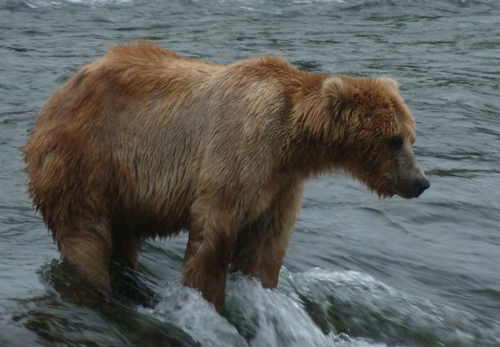Watching the bearcams on explore.org gives anyone with internet access an opportunity to experience the dynamics of a bear’s world. We get to observe the playfulness of cubs, the intimacy of mating, and the satiation of hunger when a bear eats a salmon. However, when we watch the cams, we will also see some unpleasant aspects of the bears’ world.
Cubs and younger bears may be killed by a larger, more aggressive bears. Older bears and injured bears may struggle to catch enough salmon to survive a long winter and lean spring. Injured bears often appear to be in obvious pain. These are difficult scenes to watch, and over the past few days one bear at Brooks Falls has obviously struggled with a significant injury. It may be difficult to watch this bear struggle with his impaired mobility, but like other injured bears he is also giving us a glimpse into the resiliency and adaptability that bears posses.

#420 in July 2007 with a broken jaw and open wounds on his side.
In July, 2007, #420, nicknamed Genghis, arrived with a broken jaw and large open wounds on each side of his body. Before these injuries, he was a fairly dominant bear often stealing fish from other bears and/or displacing them from preferred fishing spots. With his broken jaw, he was no longer very dominant. Although smaller bears did not challenge him, he would not challenge other bears. His injuries lowered his position in the Brooks Falls hierarchy.

#435's yearling cub limped on an injured leg for most of the summer in 2007.
Around the same time in 2007, #435, nicknamed Holly, arrived with a yearling cub. The cub was limping noticeably, and it would put no weight on one of his front legs. With impaired mobility, this bear family was competitively disadvantaged. #435 would not visit Brooks Falls to fish and the cub would not be able to flee any threats.
Many people wondered, will these bears survive and will someone help them? Park rangers and biologists will not intervene to help an injured animal. “Bears injured naturally will not be tranquilized for veterinary care” (Katmai National Park Bear-Human Conflict Management Plan, 2006). Injured bears will also not be euthanized unless they pose an imminent threat to human safety. Will they survive? That was something, at the time, we could not answer.
Both #420 and #435 plus yearling modified their behavior to deal with the injuries. #420 would not steal fish in early July, but he still used his size to maintain a good fishing spot at Brooks Falls. By gingerly chewing salmon on the unbroken side of his mouth, he was able to maintain his weight and size. In 2009 and 2010, he was one of the most dominant bears at Brooks Falls.
#435 reacted to her yearling’s limited mobility by fishing around the mouth of Brooks River where larger, more aggressive bears are less frequently seen. She also appeared to move more slowly to allow the injured yearling to keep pace. By September, 2007, the yearling’s leg had healed. In 2008, the former yearling cub was seen as an independent bear and no sign of the injured leg. He is now #89 (Backpack) a young adult male who is frequently seen on the Falls and Lower River cams.

#435's limping cub in 2007 is now a healthy looking adult male.
This year #469, is frequently seen slowly moving around Brooks Falls. His left hind leg and foot are swollen. The bear moves slowly, using its three other legs as crutches. Even when standing still, the injured leg bears no weight.

In early July 2013, #469 arrived at Brooks Falls with a severe limp. This bear often had trouble moving through the river and maintaining prime fishing spots.
We don’t know how this bear was injured, nor do we know when he was injured. Since 2001, he has only been seen in the fall, never in July. Perhaps this change in habit is a result of the injury. #469 may have to take additional risks around other bears and people at Brooks Camp in order to eat and heal.
These are three bears with three stories to tell. #420 and #89’s stories show how bears are able to modify their behavior and movements to deal with injury. These are adaptable and resilient animals. Of course, we don’t yet know the outcome of #469’s story, but he may yet provide us with another example of a bear’s remarkable ability to adapt, heal, and survive.
